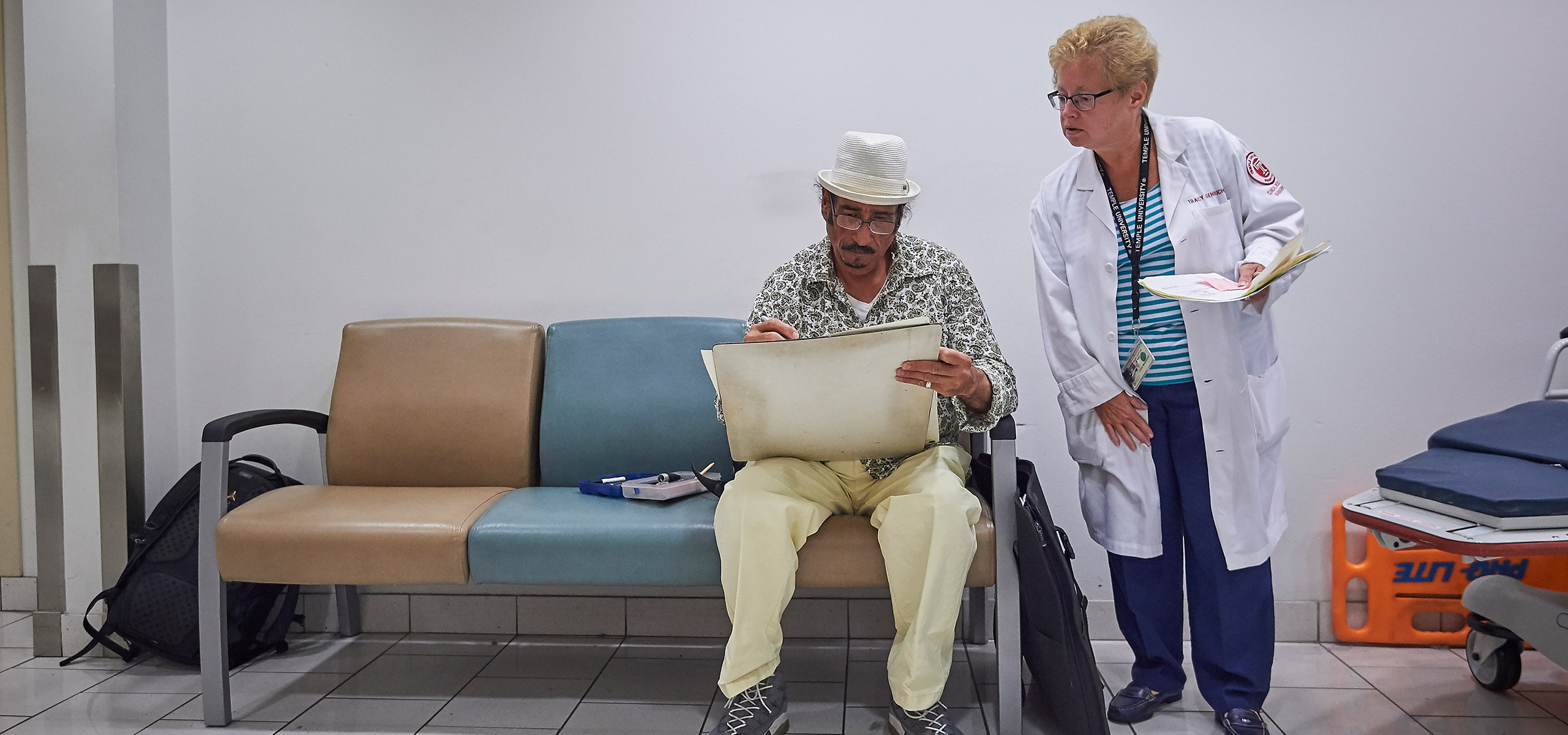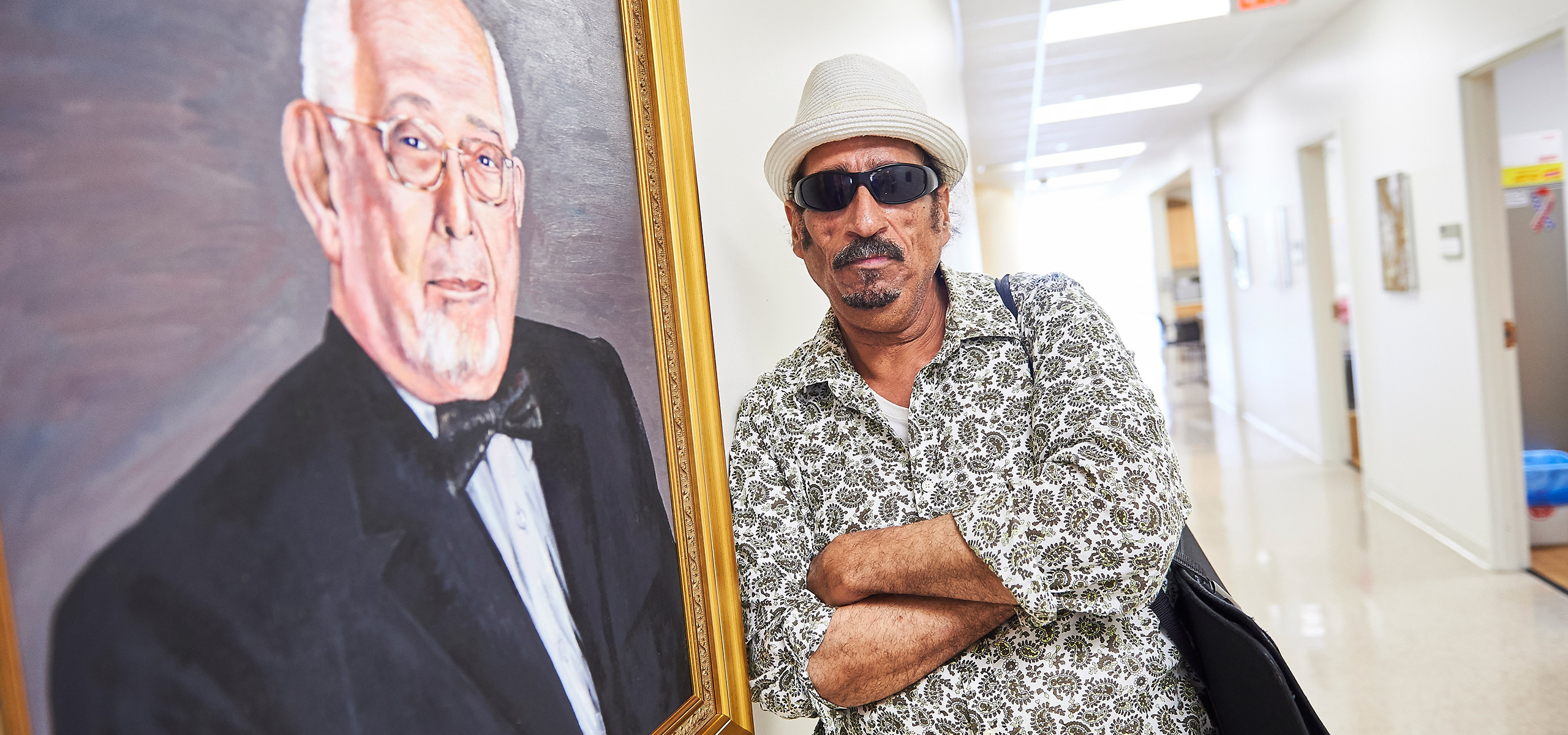The Artist in the Lobby

By Michael Vitez | August 1, 2016
The artist comes in every morning, for 10 years, 15 years, he can’t remember.
He stops at the visitor’s desk in the Tioga Lobby of Temple University Hospital and picks up an outpatient pass. He almost never needs to ask. They just know him.
He carries his portfolio case, big, rectangular and black, filled with drawing pencils, paper, his latest work, and assorted other things – a roll of paper towels, or toilet paper if he’s stopped by the store on his way here, or a bag of chips, maybe a sandwich.
These days, the dead of summer, he wears shorts and sneakers, but also a windbreaker jacket because the hospital can get cold. He finds a bench in the lobby. And he goes to work.
This is his office. Jonathan Thomas, 60, lives alone, in a small apartment on Erie Avenue. He has few close friends in the world, no wife or children. But here he comes every day, to draw portraits.
“I feel comfortable here,” he says. “Better than I feel when I’m at home. Any minute somebody’s going to come up and give me a compliment about my artwork. It’s a pleasant place.”
Doctors, nurses, patients stream past. Many have been coming through this lobby for years and never noticed him. But some stop, admire his work, give him business.
The other day, for instance, LaLandra “La-La” McDaniel, a longtime patient, greeted him warmly on her way out. He looked up from his drawing and broke into a big smile.
“Hey La-La,” he said.
She befriended the artist maybe 10 years ago.
“I just saw him drawing and asked if he could draw a picture of my daughter when she was a year old,” McDaniel recalled. “And then I asked him to do another one of her graduating from high school. It is beautiful.”
 He works from a photograph.
He works from a photograph.
“He captures details that you didn’t realize were there,” McDaniel said. “He makes it look exactly like the photograph, even better.”
Kathleen Welsh, a nursing recruiter in the Boyer Building, noticed the artist one day this spring and hired him to do a portrait of her son. She gave it to her husband on Father’s Day.
“Oh my god he loved it,” she said.
Thomas did it in less than a week, and Welsh paid him $50.
“I don’t know what his story is behind the scenes,” Welsh said. “I thought it was worthwhile on many levels.”
Thomas said he started to draw when he was seven. He watched Batman on television and began drawing the superhero on notebook paper with crayons. His parents recognized his interest, and skill, and began buying him sketch paper, pencils, and art supplies. He has read books, but is entirely self-taught. He uses a ruler and compass to measure key features on the photograph – say, the distance between the eyes – and keeps the same scale as he doubles, triples or quadruples the size of the image in his drawing.
Thomas says things that let you know he’s had hard life, and a complicated one.
“I had a whole art studio, but they stole it. The junkies stole it.” He also says he has been cheated by people once close to him.
Asked how a man who draws such lovely pictures can have such a dark view of life, he replied: “It’s an escape, a total escape from the real world. I’m making my own world, drawing these pictures.”
Thomas says he’s poor, on disability, and selling his artwork helps him out a little. He also comes to Temple for care. He has chronic vision problems – he’s blind in his left eye now, and often uses a magnifying glass. He has an appointment every three months with other specialists, but chooses not to elaborate. “That’s nobody’s business.”
He loves to watch the world pass by, a parade of canes and white coats, oxygen tanks and tank tops. “You could go to Hollywood,” he said. “You could go, I don’t care, to a war somewhere, to the park. But you’ll never see the variety of people like you do in the hospital. All shapes and sizes and sicknesses and races.”
Maybe his best friend at Temple is Peter Doukas, dean of the School of Pharmacy. Doukas first met Thomas years ago after a colleague used the artist for a portrait of a former associate dean. Doukas has become a supporter and fan.
“He drops by every week to say hello,” Doukas says.
Thomas is also quite a guitar player. “He is teaching me the blues,” said Doukas. Sometimes they jam in the dean’s office.
Doukas marvels how Thomas can draw with such precision and perception with vision in only one eye. He has helped the artist find other work at Temple: a portrait by Thomas of Miles Davis hangs in the Boyer School of Music, and nine drawings hang on the second floor of the Maurice Kornberg School of Dentistry.
As a PhD student, Doukas worked in the lab of Temple icon Dr. Leon Salganicoff, a researcher and professor of pharmacology in the School of Medicine. They became very close. When Salganicoff retired, Doukas recommended he use Thomas to paint his portrait.
Thomas normally draws in pencil, but this portrait was in oil. Salganicoff loved it, Doukas said, but died months before the dedication ceremony.
Thomas, who said he was paid $500, had never seen the portrait hanging in the medical school. In fact, he doubted it was even hanging. That is his worldview.
The other day, accompanied by this writer, Thomas walked from the hospital, across Broad Street, to the medical school.
He took an elevator to the 9th floor. There it was. Outside the Department of Pharmacology, prominently displayed.
At first the artist just stood there, partly in disbelief. Then his normally poker face broke into a big smile. He was so pleased to see his art so obviously valued. And then it was as if he’d been reunited with an old friend. He leaned in close, touched the canvas, and admired his work.

Michael Vitez, a Pulitzer Prize-winning journalist, is the new Director of Narrative Medicine at Lewis Katz School of Medicine. His mission is to focus on the human side of medicine, to encourage staff and students to reflect and share their stories and to tell stories himself. He can be reached at Michael.Vitez@temple.edu. Read more from Temple's Narrative Medicine Program on Medium.
